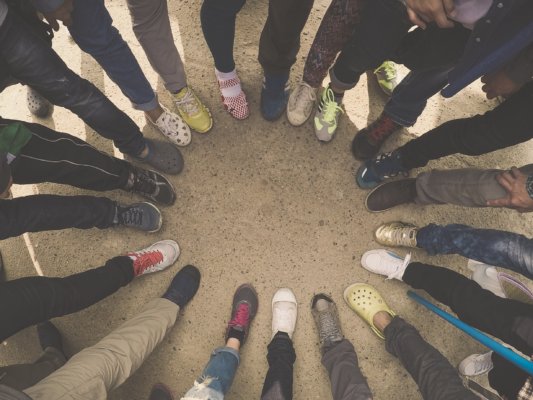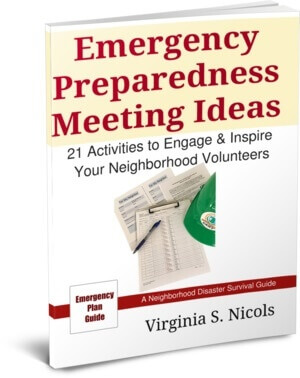
The more I learn about preparedness, the more I see that genuine security for your family depends on far more than you alone can do. In other words, preparedness takes a village, with every member taking a role.
So as we head into 2020, let’s take a look at some of the options you have to improve your situation and the situation of the people around you, too.
You must take the initiative to keep your family safe.
Here at Emergency Plan Guide we try not to discriminate between young or old, single or married, urban or rural preppers. However, we do aim our outreach to the kinds of friends who are looking for “practical, simple and sensible every-day actions” they can take to become better prepared. (By and large, these friends don’t plan to depend solely on the government or other “authorities.”)
In September, FEMA’s 2018 annual National Household Survey came out. I was interested to see how our preparedness objectives fit in with what the survey reports!
According to the survey (5,000 people across the country), 57% of us have taken at least 3 or more “preparedness actions.”
FEMA identifies six basic preparedness actions.
Below is a list of what FEMA counts as “actions.” How many of these actions did you take in 2019?
- Gather and store 3-days’ worth of emergency supplies
- Talk with others about getting prepared
- Attend a local meeting
- Seek information on preparedness
- Participate in a drill
- Make an emergency plan
Did you take all six actions in 2019? If not, what can you add to your “to-do” list for 2020?
What keeps us from doing all six?
If you read more deeply into the results of FEMA’s study, you’ll discover that of the people interviewed, 97% admitted that at least one disaster could impact where they live – but only 47% of them feel confident that they can prepare effectively.
47%! That’s nearly half! What stands in their way? The study quotes the same “reasons” we’ve heard for years: (1) perceived hassle (2) anticipated cost (3) don’t know exactly what to do.
(When I look at this list, I see “reasons” we give for not doing a lot of things! For example, I can easily apply all three of those reasons to buying or selling a car, changing dentists, applying for a new bank account, etc.!)
Getting more people involved depends on what’s going on in your neighborhood.
If you look back at that list of preparedness actions, you’ll see that half of them can be accomplished by working on your own – but the other half require participation by others! Yup, that the “preparedness takes a village” aspect!
And here’s where Emergency Plan Guide stands out from most other resources. We’ve written community preparedness into every one of the books in our Disaster Survival Series.
You want your neighbor to be ready to help.
After all, that neighbor is likely to be YOUR first responder in an emergency!
The FEMA list cites the value of “talking with others,” “attending local meetings” and “participating in a drill.” Somebody has to manage these – they don’t just happen by themselves.
CERT training, offered by local emergency management office, usually becomes the basis for neighborhood readiness. But the next step requires local community leaders to step up. Our Emergency Preparedness Meeting Ideas book is aimed at those leaders, helping them in planning and putting on educational neighborhood meetings. (This is our best-selling book, by the way!)

What role can you take in 2020 to support your local neighborhood?
If your job disappears, all your personal work may be for naught.
The past several years we have seen whole communities decimated and destroyed by flood, storm, and fire. Even if people escape with their lives, when businesses are destroyed a lot more “goes up in smoke:”
- Employees no long have a source of income.
- Business owners lose their investments.
- Suppliers and advisers lose a client.
- Customers lose a valued product or service.
- The community loses vitality – and tax revenue.
Our book Emergency Preparedness for Small Business helps business owners make plans — for protecting their business in the face of a disaster and getting their business back up and running if the disaster actually hits.
Business preparedness depends on a whole team.
The concept of teamwork really stands out when it comes to business continuity planning. In the book we spend time on the professional team of advisers that a business typically has in place – but may not have called upon to help it build a plan!
These advisers include:
- Skilled and experienced employees (and not necessarily just upper management)
- Business attorney (who can assess contractual liabilities associated with disaster and, in particular, liability associated with not having a plan)
- Business accountant (helps identify value of equipment, business activities, etc. and thus helps set priorities for protection and recovery)
- Business banker (prepared to offer emergency funds, extend loans, etc.)
- Business insurance agent (with added expertise in Business Interruption insurance, Extra and/or Contingent Expense coverage or riders)
If you are a business owner or a member of management where you work, how would you assess your business continuity plan? Have professional business advisers been involved in putting it together? Is it time for a review of your plan?
What’s your plan of action for preparedness in 2020?
In the midst of everything else that is happening, can you commit to improving the resilience of the “village” around you?
This Advisory lays out several broad suggestions. I hope you’ll take up at least one of them!
In the meanwhile, we’ll keep examining options in more detail here at Emergency Plan Guide. We would very much appreciate your help in that – in the form of questions, comments, and suggestions. Here’s to a very busy 2020!
Virginia
Your Emergency Plan Guide team
P.S. I would also welcome your offer to write a guest advisory! Do you have something you’d like to share? Let me know and we’ll talk about the best way to get your good info out to “our” village here!
Don't miss a single Advisory.
Thank you for subscribing.
Something went wrong.
